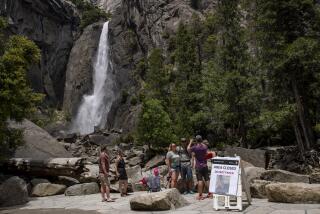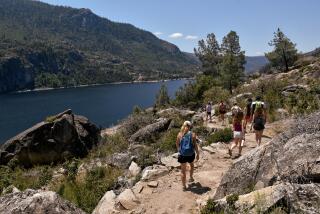Blemishes on Yosemite
Mention Yosemite National Park to people and visions of El Capitan in a winter storm or memories of summertime hikes to high Sierra camps come to mind. Sewers and water systems would not be high on anybody’s list--nobody’s, that is, except park superintendent Jack Morehead. He knows that if those systems don’t function, that failure could quickly corrode the beauty of a park visit. And all the systems from Tuolumne Meadow to Crane Flat to Glacier Point and Badger Pass badly need work.
The problem is, as usual, money. There is never enough. In recent years Yosemite has done well in the park appropriation process--well in comparison with other parks, that is. Much of that money has been spent on big water and power systems for Yosemite Valley and the Wawona area. Those areas do, after all, draw the bulk of park use.
If Yosemite’s building appropriation returns to more normal levels below this year’s $7 million, the park will never catch up with its needs. The cost of repairing the water and sewer systems and improving employee housing is $20 million to $30 million. The construction budget for the entire park system is $30 million. Knowing the facts of fiscal life, Morehead has drawn up a list of priorities and is working his way through them.
Topping the priorities list is the rehabilitation of both sewage and water systems throughout the park. In a place like Yosemite, there obviously aren’t sewers and drains and treatment plants. Its areas have self-contained systems with septic tanks and leach fields. Not to get too graphic about it, Morehead wants to go in the direction of vault toilets that store waste in concrete vaults until it can be hauled out of the park to treatment centers.
In Yosemite there is water everywhere in a good year, but it must be collected, stored and treated, and Yosemite needs a better system to do that. The one that it has now works all right in a wet year, Morehead said, but in a dry year it fails. This year campers at Vogelsang faced water rationing all summer. Mules carried water to the Sunrise camp during the last few weeks of the season.
Next on Morehead’s list is the maintenance of employee housing. Almost a third of the buildings for year-round park workers are more than 50 years old. Insulation is inadequate, roofs need replacing and central heating is non-existent in many of the buildings. The superintendent himself heats his house with a wood stove. That’s quaint, until you have to get the wood in a snowstorm.
Some repairs are getting done. For several years the bridge has been out over Conness Creek, separating Glen Aulin camp from the main hiking trail. Fording the creek is no problem late in the season when the water is low, but it has been a trifle tricky earlier in the year when the runoff is brisk. Trail crews are finishing the work before the snows force them out of the area.
When people talk about the nation’s decaying “infrastructure,” they usually mean city bridges in danger of collapse or school buildings wearing out. Yosemite and other national parks contain parts of that infrastructure as well, and they too must be maintained. Americans go to Yosemite for rest and recreation, not to face the same crumbling environment that they deal with at home.
More to Read
Sign up for Essential California
The most important California stories and recommendations in your inbox every morning.
You may occasionally receive promotional content from the Los Angeles Times.










